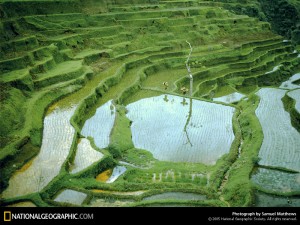The cultivation of rice is absolutely essential to the collective human diet, with 40% of the world’s population depending on it as its major food source. Most of the primary producers are located in Asia, where rice paddy fields make up 70% of the cultivated area in southern China and accounts for 50% of the daily calories consumed by Indonesians. Unfortunately for us, lowland rice cultivation is also one of the primary contributors of methane (CH4) gas into the atmosphere, emitting an estimated 20-100 Tg of CH4 per year into an atmosphere already stressed with growing CO2 emissions. Worse, methane gas is 21 times more potent a greenhouse gas than CO2, so has an enormous impact on the warming of the climate.
Unlike CO2, methane is produced by microbes which thrive in the bodies of animals like cows, goats, and sheep, as well as through anaerobic decomposition of organic material in agricultural fields. Rice paddy fields, where rice is grown under a layer of standing water several inches thick, are a perfect environment for CH4 production. Some methane does come from natural sources like wetlands and permafrost, but the IPCC estimates that 60% of the CH4 load currently in the atmosphere was put there by human activity. Animal agriculture, fossil fuel production, landfills, and animal waste management all contribute to the annual CH4 output.
By 2100, the world population is predicted to rise to approximately 9 billion residents. Already, in the past 150 years, CO2 emissions have increased over 31% and methane production has nearly doubled. Since the population growth is centered in southeast Asian countries like India, and Indonesia, the populations that rely the most upon rice in their everyday lives. Drastic changes to the way we grow rice will be necessary if we have any hope of producing enough to feed that many people without suffocating our planet.

Upland rice cultivation, when the fields are not submerged, are far more environmentally friendly than lowland rice cultivation, where the fields are submerged.
Studies are already in motion regarding ways to limit the amount of water in the rice fields of China, India, Indonesia, and Thailand. A new irrigation system, called “water-saving irrigation,” removes all water from the paddy fields after the stage of recovering the seeds, and is already in use in China. This method not only preserves water, but it actually increases rice yields and limits the time that microbes have to produce methane in the fields. Techniques such as this will need to become more widespread, quickly, to decrease the output of this dangerous gas.
Other ways to decrease CH4 emissions:
Decrease meat intake. One of the quickest, surest, and perhaps easiest ways to decrease our production of methane is to limit our intake of meat products. An average of 80% of the methane produced every year comes from the digestive tracks of animals, so limiting the number of animals raised will contribute hugely to decreasing our methane output.
Landfills account for 34% of methane emissions in the United States, as waste decomposes in anaerobic conditions. The EPA has developed a volunteer Landfill Methane Outreach Program to begin reducing the methane output from landfills.
